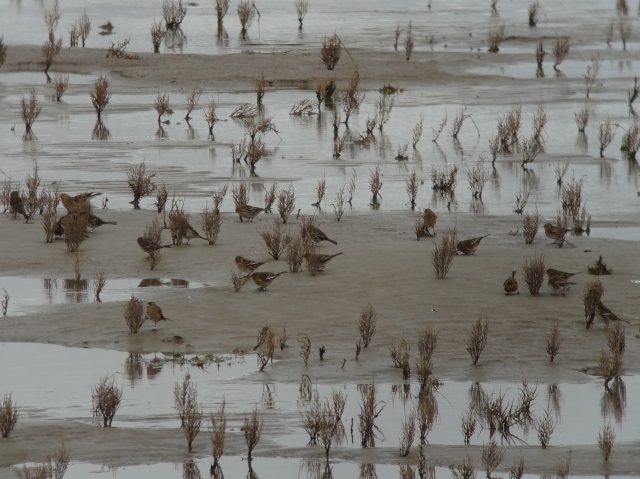It’s Wednesday and we’re heading up north for Jane’s mum’s 80th birthday celebration, when the text came through about the relocation of yesterday’s Semipalmated Sandpiper, at Pilling Lane Ends, on the southern edge of Morecambe Bay. We’re only an hour away and by the time the car is bouncing down the rutted track that leads to the sea wall and we see the small group of birders, huddled against the wind staring out across the bay, I’m feeling uncharacteristically optimistic. This turns out to be misplaced anticipation, as the bird had flown off almost as soon as the news was put out and hadn’t been seen since! As the small crowd began to disperse, in the aftermath of the adrenalin-filled moments of success, we scanned the truly vast expanse of mud which stretched to the horizon – pockets of waders, mostly Redshank and smaller Dunlin, with which our target was apparently associating, could barely be made out on the rapidly receding tide-line. Semipalmated Sandpiper is one of the ‘peeps’ from North America and the rarest of the ‘big five’ that most regularly grace these shores – the others, which we’ve already seen this year being White-rumped, Baird’s, Buff-breasted and Pectoral. We spend the next half hour peering through scopes to see if we can find any smaller birds in these random flocks – more through hope than expectation. A couple of winter plumage Sanderling get the pulse racing but, even at that distance, we can just make out enough detail to ‘eliminate them from our enquiries’. News of a flock of wintering Twite, further up the Esplanade, is a welcome distraction and we wander off to enjoy their ‘Mexican wave’ feeding antics. By now it’s lunch time so we decide to head into Knotts End for some ‘snap’ and resume our search, where the bird was originally discovered.
After lunch, fortified against the elements, we continue the near impossible search for a wader, little bigger than a sparrow, lost in several square miles of Morecambe’s mudflats. There was nothing of interest from the Esplanade so we decide to return to Cocker’s Dyke, where the bird was seen earlier. We arrive to be greeted by the frustrating news that, whilst we were enjoying bacon balm cake and chicken & mushroom pudding, the bird had put in another brief appearance! We were pointed in the direction of a flock of Dunlin, pin-heads in the glittering afternoon sun – ‘we think the bird’s in there somewhere’. For the next half-hour or so we watch small flocks of Dunlin fly along the coast, occasionally coming closer to wash and preen in the fresh water of the outflow stream. Hope again began to subside and collective attention was beginning to wane, when I saw another smallish flock arrive to bathe. A quick sweep through revealed the presence of a small ‘peep’ at the right hand end of the flock. It’s overall busy ‘jizz’, long winged, dark capped with pale ‘super’ before the eye, uniform back and white bellied appearance strongly suggested that this was our bird! The general consensus was in agreement with my id and I attempted to secure a few digipics which might help clinch it. In absolute truth, at such a distance, it was difficult to be conclusive but I was lucky to secure enough photographic evidence to put the matter safely to bed. See below:
Even at this distance the overall longish primaries, uniformed back, white underparts, dark-capped head with white ‘super’ and short black bill give confidence to the id of Semipalmated Sandpiper. There is even the hint of the palmations ( webbing between the toes) on the birds raised left leg.
Part of a flock of fifty Twite feeding in a ‘Mexican Wave’ manner
1st winter Ross’s Goose at Marshside NR
With an hour or so of day light left and buoyed by our success, we made a mad dash to Marshside NR at Southport, where we caught up with the first winter Ross’s Goose. Although we missed out on the freshly reported American Wigeon at the same location, it was still a great end to a memorable days birding in the North West. As I inch ever closer to the ultimate target I’m finally beginning to believe that 300 for the year might just be possible!



